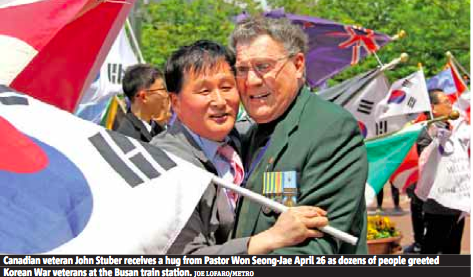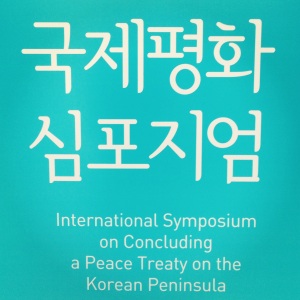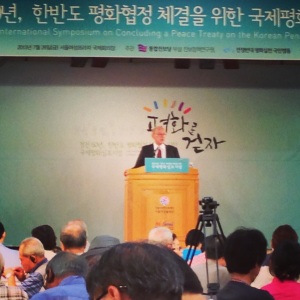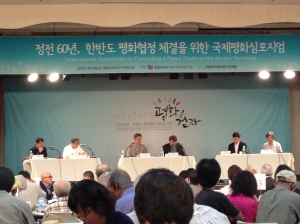We can easily forget as foreigners living in Korea that we are living in a forcibly divided country still at war. Join the ISC in a reunification tour to explore regions of significance to the inter-Korean conflict. You can sign up at http://bit.ly/1eTvmEL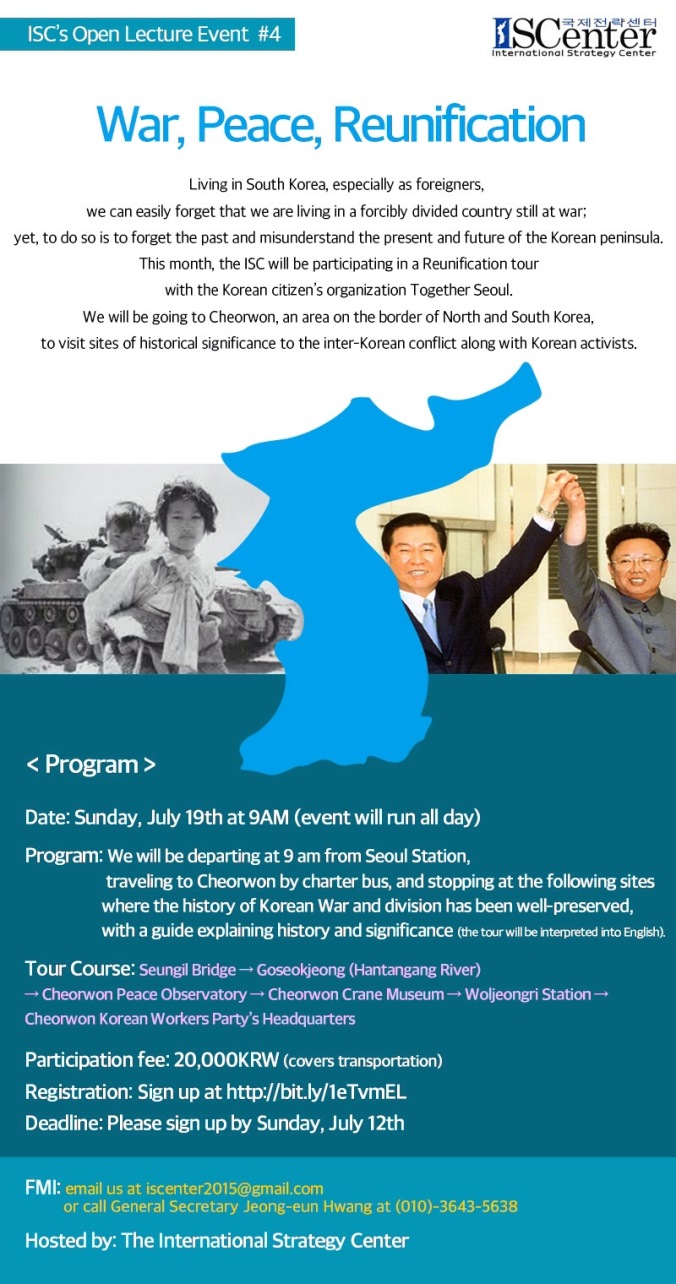
North Korea
Reframing Reunification
By Stephanie Park
I don’t remember exactly when I learned about Korea’s division into North and South; but I do remember the immediate conviction I felt that the two should be reunified. I didn’t know much about the South, and even less about the North, but my childhood self was convinced it needed to happen. Perhaps, I perceived a desire, unspoken but felt, of my grandparents to return to the provinces where they were born. Perhaps I was simply parroting the idea that Koreans were one people, and should therefore be one nation as well[1]. Or perhaps I just liked the idea of a happy ending. Regardless, before I became serious about critically examining Korean politics, reunification was the one topic I had any opinion on.
It was thus disorienting when after the ISC’s June program on reunification, I found myself more confused about the issue of reunification than I had ever felt before. Addressing reunification is impossible without addressing the matter of “the world’s most isolated country[2].” While I’m no expert on North Korea, like countless others I had always assumed that there were certain things I could simply take for granted: for example, that the North was responsible for the Korean War, that it brainwashed its citizens into worshipping Kim Il Sung and Kim Jong Il, and that the country was hell-bent on building up its nuclear weapons program to threaten the US and South Korea. Volunteering with North Korean defectors gave me an additional perspective, one that focused on the scarcity of food and resources and painted the situation in North Korea as a human rights issue. I was therefore taken aback by the attitudes of the South Korean activists that we met and their attitude towards the North, which was more nuanced and challenged me to critically examine everything I’d ever thought about the country. As I investigated the issue further, I began to realize how little I knew of the forces that shaped the North Korea that we (think we) know, how deeply and completely my and others’ understanding of North Korea has been shaped by American neoliberalist motives, and above all, that a paradigm shift is necessary to achieving a reunification that truly achieves peace and justice on the peninsula.
As I delved into Korean history to seek answers, I found that to discuss reunification necessitates discussion not only of North Korea, or even the Korean War, but of Japanese colonialism. In a way, the conflict between North and South reflects the still-unresolved conflict between Koreans themselves during the occupation between those who resisted and those who collaborated. The current power hierarchies of both countries reflect that, with the Kim family and other guerilla fighters at the helm in the North, and collaborators who stayed in power through US intervention in charge the South. The unresolved trauma of Japanese colonialism was so central to Korean politics at the time that, in the opinion of historian Bruce Cumings, “a civil conflict purely among Koreans [emphasis added] might have resolved the extraordinary tensions generated by colonialism, national division and foreign intervention. [3]” Yet, such a resolution was never to be, as Korea was divided arbitrarily by the American military and summarily offered to the USSR as a preemptive compromise in the Cold War conflict. Korea’s division was something I had simply accepted as a child, but revisiting it now, I am struck by the arrogance of dividing another people’s country without any thought to those that inhabit. Yet, this act shows that, from the very beginning, America’s treatment of Korea’s was never that of equals, but as a pawn to be sacrificed to further US interests. Similarly, I had always thought of the Korean War as the fault of a blood-thirsty North; yet if we contextualize the war as a civil conflict in the wake of division by more powerful countries compounded by the lack of resolution of the injustices from Japanese colonialism, it becomes clear that civil wars do not start, they come. [4] If we examine history, it is clear that both Kim Il Sung and Synghman Rhee desired war to reunify the country. Yet, despite its civil origins, once the war began there were just as many atrocities committed by the US against Koreans than between Koreans themselves, including the massive use of chemical weapons, systematic burning of villages, and destruction of dams affecting 75% of North Korea’s food supply[5]. Perhaps most tragically, the bloodshed proved to be for nothing, as the war ended in an armistice, leaving both Koreas in a state of war to this day. As a kid, I’d grown up with the narrative of MacArthur sailing into Incheon to “save” the Korean peninsula, but given his support (and even advocation) of bombing the North in the name of procuring military victory, it’s clear that the US’ presence brought more death and destruction than it ever brought peace.
Of course, when we think about North Korea today, it is usually with regards to its nuclearization. The imagery of North Korea as a crazed weapons-stockpiling nation that could go berserk at any moment is one that dominates both mainstream media and my family; yet, a critical examination reveals that North Korea’s developments have largely aligned with the desire to either a) exercise self-sovereignty, or b) react defensively to US actions. For example, much was made in 1993 of North Korea’s withdrawal from the Nuclear Non-Proliferation Treaty – but how many people knew that it was due to the International Atomic Energy Agency (IAEA)’s demands to carry out “‘special inspections’” in North Korea, ones which could be utilized to gather intelligence for the United States (a violation of the IAEA’s own mandates)? Similarly, while I had always agreed with the US’ mandate that North Korea de-nuclearize, upon further investigation, I realized how the US has utilized a denuclearized North Korea as a tool to push for unrestricted access to North Korean information, essentially holding peace in the peninsula hostage[6]. Aside from being hypocritical,[7] it’s also a clear violation of any country’s basic right to sovereignty and attempt to subordinate North Korea.
Of course, the fact that such information rarely comes to light is indicative of just how successful American media has been at naturalizing its own stance, and delegitimizing the North Korean perspective, to the point that even those interested in international solidarity continue to see North Korea as simply “that crazy country.” Yet, for all the focus on North Korean propaganda, we fail to see how deeply ensnared we are in our own. We call North Korea “ ‘crazy’ ” – but is it any crazier than a nation that claims to value justice and equality for all, while actively punishing a country whose actions are in the name of self-determination? Is it any crazier than a country that decries the human rights violations in North Korea, yet implements sanctions and refuses to provide aide and is thus directly responsible for these problems in the first place?
I am still struggling to develop my own understanding of reunification and North Korea while holding the contradictions that have developed and that sometimes seem to pull me in opposing directions. How do I honor my grandparents’ history (and thus, my own) while also challenging it? How can I have admiration for the North Korean defectors I have met for their courage, and respect the hardships they have endured, while also not falling into the trap of praising them simply because they defected and contributing to their use as political tools of the US and South Korea? And how can I have an understanding of North Korea and reunification that is critical yet hopeful? I confess that I don’t have an answer to these questions yet. However, one thing I do know is that, as an American, I recognize the burden we bear as citizens of a country who has wronged the Korean people, North and South, and promise to do what I can to contribute towards restoring peace and unity on the peninsula in a way that has the Korean people at heart.
[1] See: Minjok ideology. According to Luc Walhain in “Transcending Minjok: How Redefining Nation Paved the Way to Korean Democratization,” “while the original meaning of “jok” in minjok was “tribe” sharing a common ancestor, “jok” is now more generally used to designate a race, or ethnic group, e.g. “mong-jok,” meaning Mongolian race. When “jok” is combined with “min.” (people), as in “minjok,” the word becomes loaded with a heavily racial character. It refers to the Korean “nation,” but puts a strong emphasis on the Korean people’s sharing of common blood and a common ancestor, Tan’gun. It is an emotionally loaded term which has been used with great effect to call for the Korean people’s absolute and unconditional love and loyalty for the nation.” (http://studiesonasia.illinoisstate.edu/seriesIII/Vol%204%20No%202/s3v4n2_Walheim.pdf)
[2] http://www.worldpolicy.org/sites/default/files/uploaded/image/Spring13_22-23_Anatomy(1)_1.pdf
[3] Bruce Cumings, “The Korean War.” (http://books.google.co.kr/books?id=lY5-7ZirsmgC&pg=PA35&lpg=PA35&dq=a+civil+conflict+purely+among+Koreans++might+have+resolved+the+extraordinary+tensions+generated+by+colonialism,+national+division+and+foreign+intervention&source=bl&ots=7GcXcT3n2n&sig=HGA7wUHvb_ogbldGv3taXJGFvLs&hl=en&sa=X&ei=v_ASVIn_AcK58gWy3ICQDw&redir_esc=y#v=onepage&q=a%20civil%20conflict%20purely%20among%20Koreans%20%20might%20have%20resolved%20the%20extraordinary%20tensions%20generated%20by%20colonialism%2C%20national%20division%20and%20foreign%20intervention&f=false)
[4] Bruce Cumings, Korea’s Place in the Sun.
[5] Bruce Cumings, Korea’s Place in the Sun.
[6] See: Korea Policy Institute’s “The Case for a Peace Treaty to End the Korean War” (https://solidaritystorieskr.files.wordpress.com/2013/04/caseforapeacetreaty.pdf).
[7] The last time the US divulged that kind of information was due to Edward Snowden, and there’s a reason he’s still in Russia.
You’ve Got Seoul- Korean War Vet’s Spirit Buoyed by Pen Pal: Metro News
Remembrance Day is held in Canada every November 11th to pay homage to the sacrifices made by war veterans. Often forgotten is the Korean War, which claimed the lives of hundreds of Canadian soldiers. Overshadowed by both World Wars and the Vietnam War, Canada’s and Canadian’s role in the Korean War is often misunderstood and under-appreciated at Remembrance ceremonies. This article, published by Metro News Canada, tells the story of one Korean War veteran who’s personal path to peace involved a pen pal relationship with a Korean woman. The article gives a glimpse into the lives of Canadian Korean War veterans, and is a reminder that the effects of the Korean War are still felt by Canadians and Koreans alike. To read the article, please download here.
The Current Status of Peace on the Peninsula: An Interview with Jejun Joo
Interviewed by Dae-Han Song
Jejun Joo is the Policy Chair of the Korea Alliance of Progressive Movements (KAPM) and the People’s Action Against the War and the Realization of Peace. The KAPM is a broad alliance of sectoral (workers, peasants, women, students, and a political party) and regional social movements in South Korea and a leading alliance for peace and reunification in the Korean Peninsula. The People’s Action Against the War and the Realization of Peace is a coalition of social and civil society movements recently created to deal with the current war crisis in the Korean Peninsula.
The interview is meant to shed some light on the current conditions on the Korean Peninsula regarding peace as well as offer analysis and perspective from some of Korea’s leading peace and reunification social movements.
Dae-Han Song: Can you provide some background to the current state of affairs?
Jejun Joo: Sure, there have basically been five agreements since 1994 between the United States and North Korea, all of which the US has consistently reneged on. I think this is the way that North Korea understands the situation: We are no longer interested in dialogue for dialogue’s sake or dialogue as a stalling tactic [on the part of the United States]. It is within this context that North Korea has realized its nuclear capability. We can see this as the backdrop to our current situation. Without any genuine dialogue between North Korea and the US, there is a high chance that tensions will continue and might even escalate.
Dae-Han Song: Do you think that ultimately the US will recognize that reality?
Jejun Joo: I think it ultimately has no choice but to do so. One important point I want to emphasize is the April 11th announcement at the House of Reps. hearing by Rep. Doug Lamborn of the leaked Defense Intelligence Agency report.[i] In it, the Defense Intelligence Agency acknowledged the possibility that North Korea possessed the ability to arm its ballistic missiles with nuclear warheads.
Dae-Han Song: Can you talk about the chain of events that led to the current situation?
Jejun Joo: If we start from 1994,[ii] it will be too long and complicated, so let’s just start a little bit closer to today. Let’s start in 2009. In April 2009, North Korea launched a rocket to put a satellite into space. Then in May, it conduced its 2nd underground nuclear test. In response, former president Bill Clinton visited North Korea that August and came back with two American journalists that were being held in Pyongyang. This was followed by another vists by Special Envoy Stephen Bosworth in December. After the visit, Stephen Bosworth announced in a press conference in Seoul that North Korea would return to the 6 party talks. The six party negotiations concluded with the February 23 agreement. The mood for dialogue greatly improved.
In 2010, between February and March there were secret negotiations held between North Korea and the US in Berlin and in China. A peace regime was even brought up as a possible scenario. However, this was all shattered in March with the sinking of the Cheonan corvette in March 26th. The sinking of the Cheonan corvette is a great example of the US role in South Korea, and if we examine it closely we can discern its motivations in the Korean Peninsula.
Dae-Han Song: What do you mean?
Jejun Joo: South Korean authorities stated that the Cheonan corvette was sunk by North Korea. Only one other country in the world agreed with this conclusion: the United States. As a result of these conclusions, South Korea levied its May 24th sanctions against North Korea and the UN issued a presidential statement. However, if you take a close look at the UN statement, it does not state that the cause of the Cheonan corvette’s sinking was North Korea.[iii] It never mentions North Korea as the cause. In other words, the only two countries that accused North Korea of sinking the Cheonan corvette are South Korea and the US. Even Russia and China criticized this conclusion.[iv] Even now in South Korean society there are many doubts as to whether or not the Cheonan was sunk by North Korea. There are many inconsistencies and unanswered questions.[v] That is why Russia and China were unwilling to sign onto the final report. Only the US agreed to back the report. Why? Well, I believe that US interests in the Korean Peninsula can be found here.
The US strategy was as follows: with the Lee Administration’s May 24th measures halting inter-Korean economic cooperation in response to the sinking of the Cheonan corvette, the Lee Administration began to apply great pressure on North Korea. Furthermore, the USS George Washington aircraft carrier entered South Korea. As soon as the USS Washington entered South Korea, China strongly protested the move. This is because the USS Washington has a military operational radius of 1000 kilometers[vi] including a long-range surveillance radar. From the point of view of China, all of its strategic information about its North Sea fleet would have been exposed. As tensions rose, South Korea now also had to purchase stealth fighters and Apache helicopters from the large US military company Lockheed Martin. Through increased tensions on the Korean Peninsula, the US was able to sell weapons to South Korea[vii] and also finally announce its pivot to Asia strategy, ultimately meant to pressure China. Thus, we can see the reason why the US supported the South Korean government’s report accusing North Korea as attacking the Cheonan corvette.
The most important consequence of this final report was that it completely stopped the dialogue that had been happening since 2009. In this way, the US gained various benefits from increasing tensions in the Korean Peninsula. When tensions escalate, opposition towards and pressure against North Korea increases and then when the US takes actions to de-escalate, it appears as if it is taking positive steps towards easing tensions while further isolating North Korea.
Dae-Han Song: Can you briefly tell me about the Obama Administration’s policies towards North Korea?
Jejun Joo: Obama’s first term was about achieving denuclearization through face to face dialogue. In the beginning he had stated that the Bush Administration’s policy of pressuring North Korea had only driven it further into developing its nuclear weapons, and that his policy would be one of dialogue. However, as he became more embroiled with the Middle East crisis, he was unable to establish a real North Korea Policy. Ultimately, he adopted strategic patience. This strategic patience contained two components: isolating North Korea and refraining from dialogue. It is in reality a strategy of waiting for North Korea to collapse. In 2008, North Korean Chair of the National Defense Committee Kim Jong Il had a stroke, and the Obama Administration decided to wait until the Kim Government would collapse. This was the origin of strategic patience. However, strategic patience failed in 2009. There was the nuclear test and as I stated before, direct talks between North Korea and the US followed in 2010, 2011, and 2012 ending with the February 9 agreement. Through this process the Obama Administration gave up one of the elements of strategic patience by moving towards US-NK dialogue. This can be seen as Obama’s 2nd term strategy.
For his second term, Obama chose Chuck Hagel as Secretary of Defense and John Kerry as Secretary of State because they both were proponents of dialogue with North Korea. This did not mean that the Obama Administration gave up on its policy of isolating North Korea: provoking North Korea with its anti-North Korea policies facilitates North Korea’s greater international isolation. The US began to escalate tensions. It dispatched B2 fighters, with its countless bombs, the strategic B52 fighters, and a nuclear submarine to participate in the Key Resolve war games that took place from March 11 to 21 and then the following Foal Eagle war games. North Korea viewed these as provocations and stated that the US is not the only country that can launch a pre-emptive attack and threatened that a single order could launch a nuclear attack on the US mainland or its military bases in the South. In addition, similarly, the Park Administration ramped up its hostile rhetoric by stating the types of measures it would take if there was a hostage situation in the Gaesong Industrial Complex. Many viewed the Park Administration’s statements as being needlessly provocative towards North Korea.
Dae-Han Song: Before North Korea had stated that denuclearization was a possibility, yet now it has switched to a policy of wanting to be recognized as a nuclear power. What has changed?
Jejun Joo: As I’ve stated previously all of the five previous agreements have always been about establishing a peace regime, denuclearization of the Korean Peninsula, abolishment of hostile policy against North Korea, normalization of relations between North Korea and the US and through this process signing a peace treaty. After each of the negotiations, agreements were made, but then the US escalates tensions which collapses the agreement. Then, we have more negotiations followed again by the US escalating tensions. This is like a hamster running on a treadmill getting nowhere. North Korea looked at this and realized that they needed to extricate themselves out of a process leading nowhere. This was the reason why North Korea announced denuclearization was no longer possible. The nuclear test and the launching of the satellite can be understood within this new North Korean perspective. Negotiations will no longer be about denuclearization, but rather about halting further expansion of nuclear capabilities. In addition, now when the US turns up the heat on North Korea, North Korea too will be able to use inter-continental ballistic missiles and possibly its nuclear warheads to turn up the heat on the US.
Dae-Han Song: What does the US want? You said North Korea wants to normalize relations with the US and establish a peace treaty. Does the US not want this?
Jejun Joo: Strategic Patience is in reality an anti-North Korea policy: we will wait until you collapse. Like I stated before, tension in the Korean Peninsula provides benefits to the US. A peace treaty in the Korean Peninsula would not be able to provide such constant benefits. Thus, from the perspective of the US, a reasonable level of tension short of full scale war is beneficial. A resolution of tensions in the Korean Peninsula would mean disappearance of demand for their arms [by South Korea], and its Pivot to Asia strategy would no longer be possible. Checking China’s expansion may be the great underlying reason for the Pivot to Asia yet North Korea is used as its justification. That is why China is ultimately against this current state of tensions with North Korea.[viii]
Dae-Han Song: Just recently John Kerry stated that he was open to dialogue with North Korea. In addition, the Park Administration stated the same. However, North Korea called the proposals for talks “empty shells” and rejected the proposals. Can you talk about Kerry and Park’s proposals? Why did North Korea reject?
Jejun Joo: First of all, John Kerry and the Park Administration stated that the talks would have to involve denuclearization. Like I stated before, a dialogue with denuclearization in mind, from North Korea’s current point of view is not possible. North Korea stated that they will no longer denuclearize. Without the US accepting very concretely some of the demands of North Korea, such as abolishment of its anti-North Korea policy, the normalization of relations between North Korea and the US, and the establishment of peace regime negotiations dialogue will not be possible. We are talking about meeting some very strategic demands. There needs to be a promise that a process will be established for these. Similarly, North Korea also rejected Park’s offers for talk for the same reason.
However, ultimately time is on North Korea’s side. They can keep expanding and advancing their nuclear program. They will keep on enriching uranium, producing plutonium in large quantities, and upgrading and testing its missile technology.
Dae-Han Song: What is the path to peace?
Jejun Joo: There is only one way: peace dialogue between the US and North Korea, as I’ve stated again and again. North Korea has been showing its willingness to move towards a peace treaty. The armistice agreement must be turned into a peace treaty. Without that, the tensions on the Korean peninsula will persist. The peace process must involve US-North Korea dialogue.
Dae-Han Song: This is an important year with the 60th anniversary of the cease-fire. Can you talk briefly about some of the events planned by the Anti-War and Pro-Peace People’s Action?
Jejun Joo: First of all, in order to demand the de-escalation of tensions through dialogue, we are doing a signature collecting campaign calling for a peace treaty. We are also planning peace envoys to the US to deliver these signatures to the White House. In July, we planned an international march from Gangjeong village[ix] to Imjingak[x] calling for peace. We also held an international forum of academics and experts on the issue of peace in the Korean Peninsula. In order to strengthen international solidarity, we will have a discussion among activists from around the world on how to realize peace in the Korean Peninsula. The path towards a peace treaty won’t be an easy one. It will take some time including more moments of increased tensions. Slowly, we will build greater solidarity with peace organizations around the world in our path towards realizing peace.
[ii] The 1994 Agreed Framework between the United States and North Korea marked the first agreement between both countries.
[v] The biggest unanswered question is how a North Korean submarine had entered and left undetected. When the Cheonan sunk, the US and South Korea were executing war military exercises in the West Sea (also referred to as the Yellow Sea), The Cheonan corvette was involved in these war games and its role was to detect submarines. Let’s take a closer look at the results of the investigation: a North Korea submarine carrying two 1.5 ton torpedoes went all the way around the Northern Limit Line…towards the three South Korean and US Aegis boats (Aegis boats are equipped with anti-submarine radar technology) and the Cheonan corvette which were participating in the annual military exercises in the West Sea. The report alleges that during this whole time as the North Korean submarine went around the NLL, it had remained undetected…the Aegis warships can detect substances 30 centimeters big from a distance of a thousand kilometers. It does not make sense that the US and South Korean Aegis ships surrounding the Cheonan corvette, which were equipped with the latest anti-submarine technology, would have been incapable of detecting a North Korean submarine at any point before or after the attack, especially as they were in the middle of military exercises. It also does not make sense that the Cheonan corvette with its anti-submarine functions would not have been able to detect the North Korean submarine. There are many other unanswered questions and inconsistencies.
[vi] A military operational radius implies that within this radius they can launch missiles and conduct surveillance.
[vii] “South Korea said on Wednesday it would buy attack helicopters worth 1.8 trillion won ($1.6 billion) from Boeing Co. to improve its ability to respond to threats from North Korea.”
http://www.reuters.com/article/2013/04/17/korea-usa-helicopter-idUSL3N0D4AU220130417
[viii] With the new Xi Jinping government, China’s interests may appear to conflict with North Korea’s, yet ultimately as tensions escalate in Northeast Asia both sides’ interests cannot but converge. If tensions continue or escalate on the Korean Peninsula, it allows the US to increase its military presence and power in the region. Furthermore, even Japan, after North Korea’s 3rd nuclear test, is discussing nuclear armament. This is very distressing for China. Strategically, China does not want a continuation of tension.
[ix] A village in an island a few hundred miles from China, at the southernmost tip of the Korean Peninsula, where a naval base, which many believe will be used by the US military, is being built.
[x] Imjingak is directly south of the DMZ, the line that divides North and South Korea.
International Symposium on Concluding a Peace Treaty on the Korean Peninsula
By Taryn Assaf
On Friday, July 26th 2013, the ISC team participated in the International Symposium on Concluding a Peace Treaty on the Korean Peninsula held at the Seoul Women’s Plaza, organized by the People’s Movement for Opposing War and Achieving Peace. The conference was attended by a number of scholars, journalists, politicians and activists from Korea, Canada, Japan, the United States and China, as well as a number of veterans of the Korean peace movement, some of whom had spent over 30 years as political prisoners. The conference addressed key issues on the topic of peace on the Peninsula and reunification of the two Koreas. Speakers investigated the “threat” of North Korea, obstacles to peace (including United States militarism and imperialism, state nationalism, and the relationships between the countries of Northeast Asia) and recommendations for peace (including reunification, normalization of relations between the two Koreas, denuclearization of Northeast Asia, and independence from the United States).
The special session, “US Hegemony and the Globalization of War” was presented by Michel Chossudovsky, a professor at
Ottawa University, an international authority on anti-globalization issues and leader in the pro-peace movement. His talk focused on the role of the US in blocking peace on the Korean Peninsula, arguing that the US has formed a neo-colonial relationship with South Korea through direct military control and indirect political control. He argued that the US-ROK alliance is not an alliance at all, rather, South Korea is under US military occupation. On the issue of denuclearization, Chossudovsky questioned “who the real threat is” to peace. He examined this in the context of North Korea’s relationship to the US, and concluded that the real threat is the US, who is unwilling to show any sort of reciprocity on the issue of nuclear disarmament. Faced with a hostile policy from the US — the number one global nuclear power with over 2000 deployed nuclear weapons currently targeted at various countries– Chossudovsky claimed that North Korea has good reason not to want to denuclearize, and that the US must take the first steps to denuclearization of the peninsula. Thus, an integral part of realizing peace on the Peninsula involves significant action on the part of the United States in ending its hostile policies and asymmetrical standpoint on the issue of nuclear disarmament toward North Korea. Chossudovsky further concluded that peace talks must encompass a repeal of the basic command structure of the military (in which the US military has de facto control of the Korean military), retreat of the 37,000 US troops in the South, and US nuclear disarmament- this would lead to military and economic liberation in the South and are preconditions for a peace treaty.
The speakers of the first session, “Ending the Armistice Agreement with a Peace Treaty in the Korean Peninsula”, included
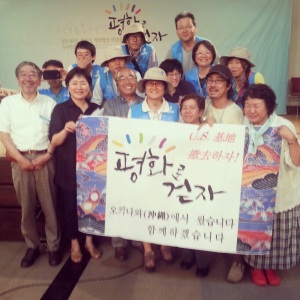
Activists from Osaka pose in solidarity with members of the International Peace March group
Gregory Elich, author and anti-war activist from the United States; Lei Xiong, Professor at Tsinghua University, Peking University, and Renmin University of China (People’s University of China); Ryoichi Hattori, Member of Japan’s House of Representatives (Social Democratic Party); Gyungsoon Park, South Korean author and Vice-president of the Progressive Policy Research Institute; and Ik-pyo Hong, Member of the Republic of Korea’s National Assembly (Democratic Unified Party). Speakers analyzed the inter-relatedness of the countries in Northeast Asia and argued that a precondition for peace on the Korean Peninsula included improved relations between China, Japan and Korea and a nuclear free East Asia. For instance, Mr. Hattori spoke of the importance of a denuclearized Japan, stating that after World War 2, Japan reformed its constitution to give up wars and nuclear weapons forever. The Korean War, however, provided a reason for Japan to re-militarize and to be used as an anti-communist outpost for the US. Currently, the Abe government is seeking to repeal the anti-war and anti-nuclear weapons reforms and further re-militarize the country. He stated that no country can justify peace by militarism and that no peace can be achieved by the production of war machines, such as nuclear weapons. The re-nuclearization and re-militarization of Japan would thus be an obstacle to peace for the region. Speakers also investigated whether peace is possible without reunification, what the obstacles to this process include and how to best overcome them. Several speakers mentioned the value of creating a safe space for a grassroots path to peace pioneered by civic and citizens groups and the importance of protecting individual ideas from repression under the banners of nationalism and state.
The speakers of the second session, “Joint Action for Peace in Northeast Asia”, included Kenju Watanabe of Japan, President of the South Korea-Japan People’s Solidarity Network and permanent board member of the Japanese Committee for Asia-Africa People’s Solidarity; Tim Shorrock, an American author, journalist and member of the Working Group for Peace
and De-militarization in Asia-Pacific Region; Jejun Joo, Policy Chair of the Korea Alliance of Progressive Movements; and Byong-ryul Min, member of Unified Progressive Party’s supreme council and founding member of the Democratic Labor Party. This session addressed how concerted actions can promote peace in the region. For example, Tim Shorrock noted the large-scale ignorance of the United States public on the issue of peace and re-unification even among leading progressive groups. He urged those in attendance to help each other educate Americans about the truth of Korean history and current affairs as they relate to peace and reunification from a Korean perspective. He labeled this as a precondition for peace, stating that the fanaticism constructed by the American media toward North Korea prevents popular support for the country and, in the minds of Americans, legitimizes United States military presence in the South, further securing the US geopolitical agenda in the region. Increasing education would likely decrease the fanaticism directed towards the North among the American general public and would create international solidarity in Korea’s quest for peace and reunification. This session demonstrated that the task of establishing peace on the peninsula extends beyond the borders of Korea- it is an issue that affects the world over, especially one characterized by a globalized economy and increasing global relationships.
Peace in Korea and in Northeast Asia is a complicated issue involving many parties, many conditions and many potential obstacles. It may not be an issue quickly resolved, but it is encouraging and hopeful to know that so many people are aligned in its recognition and are so tirelessly working for its realization. Conferences such as these are necessary steps in initiating and engaging in constructive dialogue targeted towards constructive goals. These dialogues, actions and initiatives help to build solidarity in the cause and are integral to peace and reunification in Korea.
The Significance of the 6.15 Declaration
By Dae Han Song
The morning of June 13, 2000 – with millions of Koreans watching on their televisions – marked a watershed moment in inter-Korean relations. What previous attempts to thaw inter-Korean relations had failed to do was instantly achieved, albeit momentarily, with the embrace between President Kim Dae Jung – the first South Korean to come to North Korea – and National Defense Commission Chairman Kim Jong Il: a cathartic moment between two leaders and two peoples of a nation divided by war and years of anti-North and anti-South recrimination and political education.
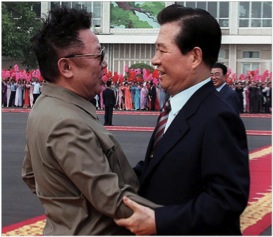 South Korea’s President Kim Dae Jung and
South Korea’s President Kim Dae Jung and
North Korea’s National Defense Commission Chairman Kim Jong Il
embrace in Pyongyang Airport on June 13, 2013.
The June 15 Declaration, which lays the framework for reunification, was the consolidation of this three day summit. Reunification was to be achieved by Korean people themselves free from foreign intervention and through a gradual reunification process involving projects fostering cooperation and reconciliation, in short, reunification through cooperation, reconciliation, and self-determination. Seven years later, under President Roh Moo Hyun, the October 4 Declaration more concretely articulated the terms of the June 15 declaration.
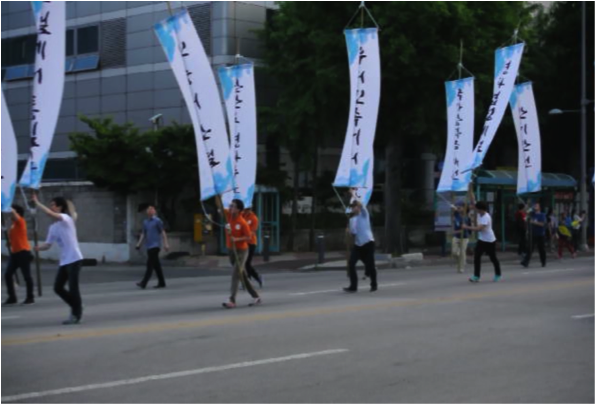 University students march in the 2013 commemoration of the May 18th Uprising,
University students march in the 2013 commemoration of the May 18th Uprising,
holding banners that read “Amongst Our Own Peoples” referring to reunifictaion
Now, 13 years later, many barriers still remain before the realization of the 6.15 and 10.4 declarations: a Korean Peninsula, that 60 years later, still remains at war plagued with tensions and skirmishes; and foreign powers that still seek to exploit its geopolitical location for their interests. The calls for the realization of the 6.15 declarations do not ignore or sidestep such realities, rather, they are defiant rallying calls to finally bring down those barriers so that a divided people can be unified and be free to choose their own path.
